Albino (Amelanistic) Corn Snake
Pantherophis guttatus
Albino corn snakes make great beginner snakes.
Advertisement
Albino (Amelanistic) Corn Snake Scientific Classification
- Kingdom
- Animalia
- Phylum
- Chordata
- Class
- Reptilia
- Order
- Squamata
- Family
- Colubridae
- Genus
- Pantherophis
- Scientific Name
- Pantherophis guttatus
Read our Complete Guide to Classification of Animals.
Albino (Amelanistic) Corn Snake Conservation Status
Albino (Amelanistic) Corn Snake Facts
- Prey
- Small rodents, bird eggs, amphibians
- Main Prey
- Rats and mice
- Name Of Young
- Hatchling, snakelet
- Group Behavior
- Solitary except during mating season
- Fun Fact
- Albino corn snakes make great beginner snakes.
- Most Distinctive Feature
- Bright red, orange, and yellow markings
- Other Name(s)
- Red rat snake, red corn snake
- Litter Size
- 12-24
- Lifestyle
- Nocturnal
- Diurnal
Albino (Amelanistic) Corn Snake Physical Characteristics
- Color
- Yellow
- Red
- White
- Orange
- Skin Type
- Scales
- Lifespan
- 20+ years
- Weight
- 1-2 pounds
- Length
- 2-6 feet
- Age of Sexual Maturity
- Reach maturity at about 30 inches long
- Venomous
- No
- Aggression
- Low
View all of the Albino (Amelanistic) Corn Snake images!
Albino corn snakes are a color morph of corn snakes with all the dark colors missing.
The first genetic color mutation discovered in corn snakes was albinism or amelanism. Dr. Bernard Bechtel first produced an amelanistic corn snake in 1961. Corn snakes are native to the southeastern United States and can live for up to 17 years in the wild.
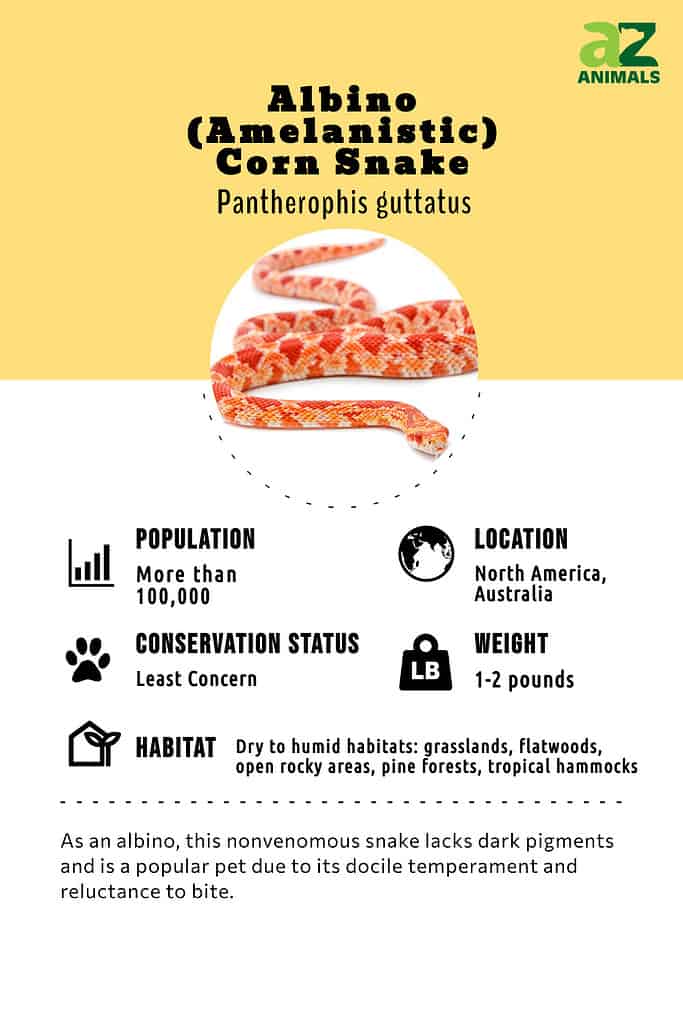
3 Incredible Albino Corn Snake Facts
- Corn snakes are popular pets because they’re fun and interactive.
- Albinism and amelanism are synonyms. It’s a naturally occurring recessive trait, but albinistic animals don’t usually survive long in the wild.
- The first albino corn snakes came from a wild-caught amelanistic corn snake.

It is challenging for albinistic animals such as the albino corn snake and the snow garter snake, above, to survive for long in the wild.
©fivespots/Shutterstock.com
Scientific Name and Classification
Albino corn snakes are members of the Colubridae family, along with the eastern rat snake, king snake, and indigo snake. Their scientific name is Pantherophis guttatus, partly Greek and partly Latin. Pantherophis translates literally as “panther snake” and is most likely a reference to the type species for the genus Pantherophis. Their specific name of guttatus roughly translates as spotted. Corn snakes’ common names are varied, and most refer to their coloration. The most common are red corn, eastern, and red rat snakes.
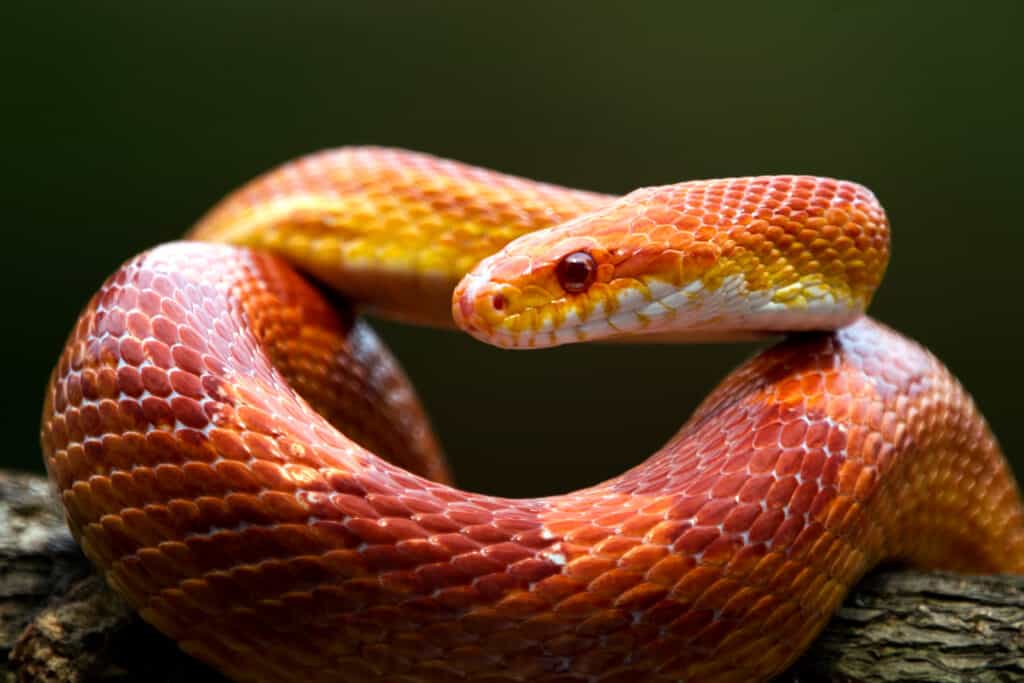
The most common color variation of corn snakes is the red corn snake.
©Kurit afshen/Shutterstock.com
Albinism vs. Amelanism: What’s the Difference?
Technically, there’s none. In this case, albino corn snakes aren’t technically albino, either. The cause of albinism or amelanism is the tyr gene, which is what provides the coding required for melanin production. The gene responsible for the mutation that caused this morph was the oca2 gene, which codes for a transporter gene specific to melanocytes. This mutation prevents any melanin that is produced from being transported to the melanocytes.
Crossbreeding Between Kingsnakes and Corn Snakes
Genetic data shows that corn snakes are closely related to kingsnakes from the Lampropeltis genus. Even more so than the Old World rat snakes where they were classified in the past. Corn snakes have also been bred with California king snakes (Lampropeltis californiae) to produce jungle corn snakes which are fertile hybrids.

Corn snakes have been crossbred with California Kingsnakes.
©Creeping Things/Shutterstock.com
Evolution and Origins
According to fossil records, snakes (including those with hind limbs) originated during the Cretaceous period. The oldest fossils of snakes as we know them is Hassiophis terasanctus, dating back 112 million to 94 million years ago. Many snake species first appeared during the Paleocene. During the Miocene, the first vipers and elapids and diversification of Colubridae occurred.
The Oxford English Dictionary refers as early as 1675 to corn snakes being present around grain stores, preying upon mice and rats attracted to the harvested corn, and thus being given the common name of corn snakes. However, others believe that the snake is named for the pattern of its scales on its belly that resemble kernels of variegated corn.
Corn snakes’ evolution includes using mimicry as a defense strategy, developing very similar coloring to the copperhead in the hopes that others will mistake it for the other, venomous species of snake.
Amelanism is the oldest color trait variant observed in corn snakes. The amelanistic morph is the most common variant in pet or captive-bred snakes around the world, with the mutation being traced back to an individual snake in North Carolina.
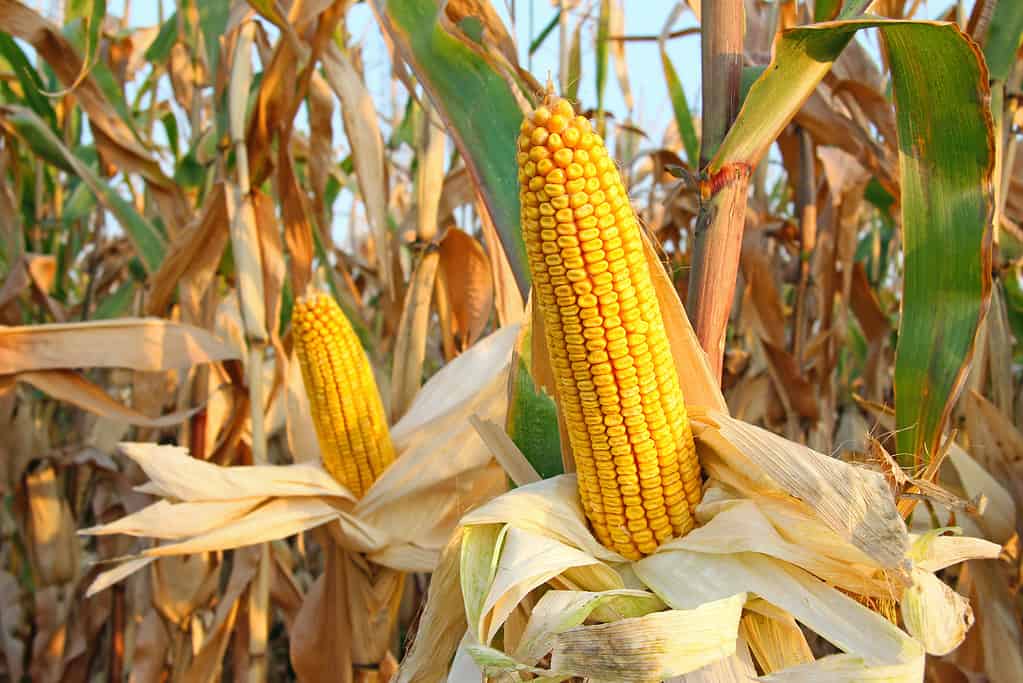
Some believe the corn snake’s name originates from its scales’ resemblance to corn kernels.
©iStock.com/branex
Appearance
Albino corn snakes have the same markings as their normally colored corn snake siblings. The difference is that, as an albino, they lack dark pigments. The remaining red, orange, and pinkish colors are vivid and striking. For more information on snake colorations, check out our complete list of morphs here. They have red round to oval markings down the length of their back, which often continues toward the belly, which has a corn-kernel pattern.
These snakes have vertical bars along their lower lip, large eyes, and slender bodies. Albino corn snakes can measure anywhere from two to six feet in length as adults and weigh between one and two pounds. They have no heat-sensing pits and are primarily diurnal.
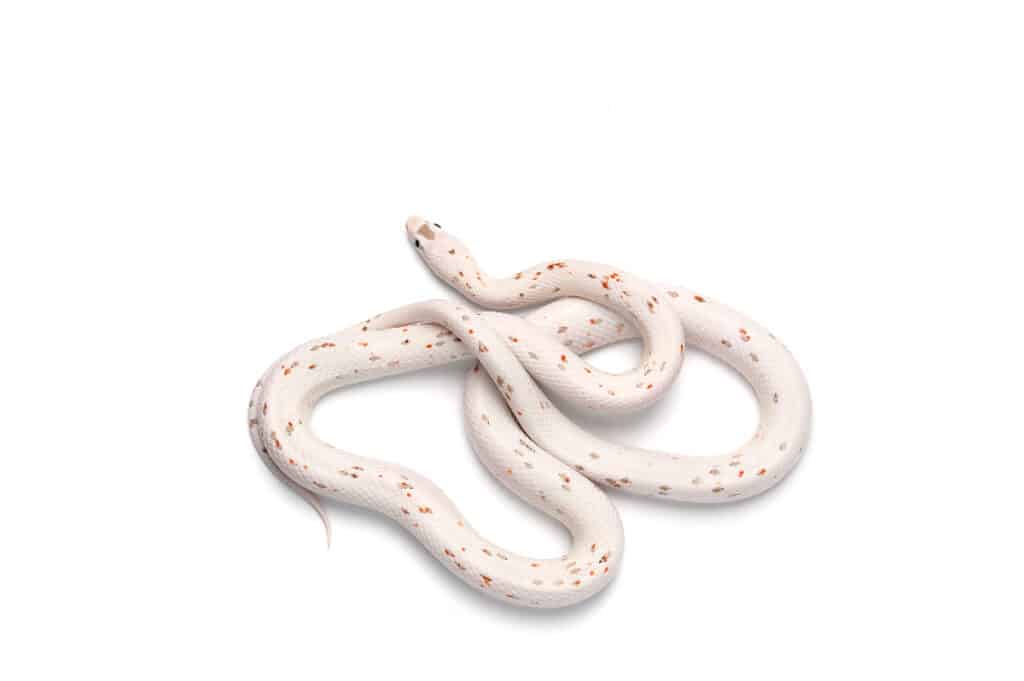
Albino corn snakes lack dark pigments.
©iStock.com/PetlinDmitry
Behavior
Albino (amelanistic) corn snakes are popular pets precisely because of their docile temperament and overall reluctance to bite. This species has been kept as pets in the reptile hobby for decades.
This diurnal snake is an excellent climber. Even though they spend much of their time on the ground looking for rats and mice, they’re just as likely to climb for food.
They’re nonvenomous constrictors that bite to grab prey, then quickly wrap several coils around it to subdue the animal. Contrary to what many scientists have believed for many years, constrictors don’t actually suffocate their food. They squeeze until the heart stops beating. Afterward, the snake can swallow its prey without injury.
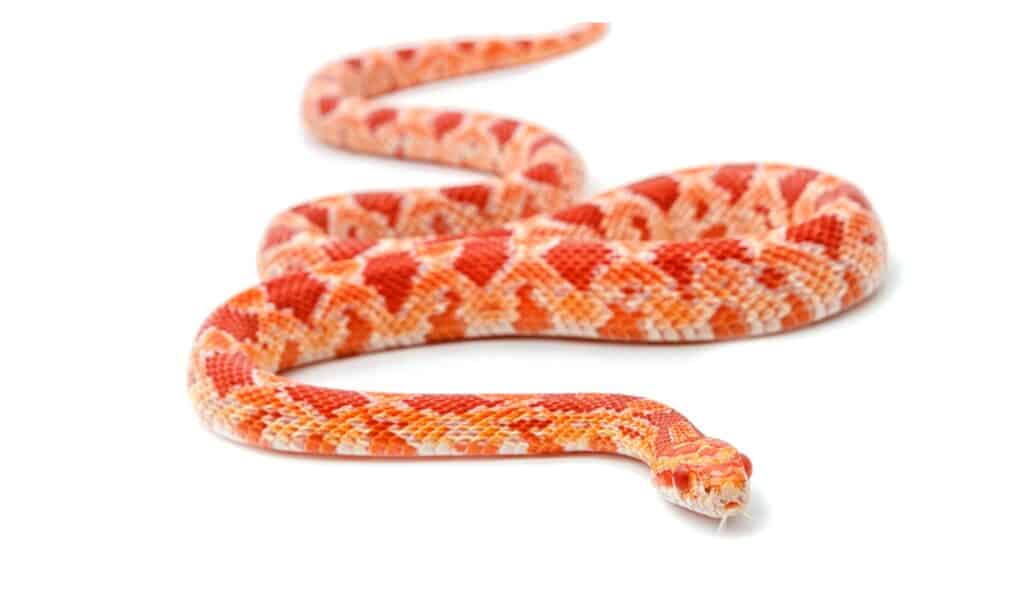
Corn snakes make popular pets due to their docile nature.
©iStock.com/praisaeng
Habitat
Corn snakes are generally semi-fossorial and occur in every habitat, from dry to humid. These snakes are versatile and frequently found in grasslands, flatwoods, open rocky areas, pine forests, and tropical hammocks.
This species inhabits a wide range of habitats in the wild. They are a common sight in the southeastern United States, from New Jersey to the Florida Keys, where they’re native.
However, their overall adaptability has gotten them in trouble because they’ve been introduced into Australia, where they’re called the American Corn Snake. There, the snakes are sought out and exterminated because they are invasive.
Albino corn snakes can be found in the wild, just like any other animal that exhibits albinism or amelanism. However, because they can’t camouflage effectively, they do not often live long.
As pets, however, they’re wonderful and very easy to keep healthy. They are active snakes with high metabolisms and need to eat once a week, if not more. These aren’t your average sedentary ball pythons. They need an enclosure with a lot of room to climb and explore.

Corn snakes in Australia are known as American corn snakes and are an invasive species.
©iStock.com/AlexKosev
Diet
This species acts as premier rodent control for neighborhoods and cities. They go anywhere they can smell food. Corn snakes are a type of rat snake, and the name fits. These snakes are known for finding their way into odd places and surprising people. As much as they enjoy a rat or mouse, they eat eggs or baby birds.
In captivity, albino corn snakes eat rats or mice, and many breeders recommend feeding frozen/thawed. It reduces the risk of injury to the snake and doesn’t add any unnecessary trauma to the prey.
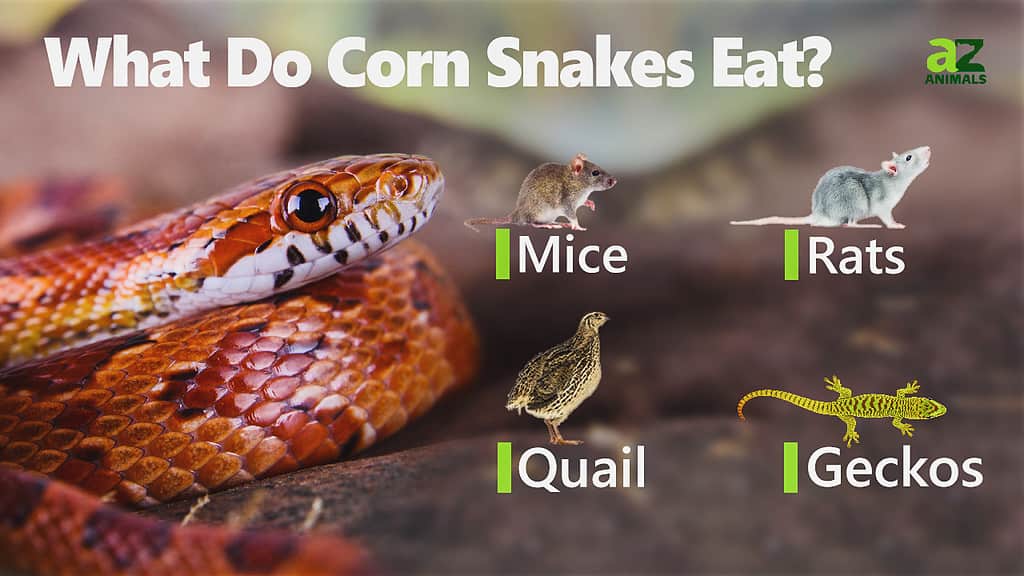
Reproduction, Babies, and Lifespan
Albino corn snakes, like other corn snake morphs, breed easily. Similarly to other colubrids, corn snakes reach maturity when they’re big enough to support reproduction; age isn’t as much of a factor.
About a month after mating, the female lays 12-24 eggs in a moist, hidden nest. Corn snakes don’t incubate their eggs and leave soon after laying them. The eggs take about 10 weeks to incubate before the baby snakes use their egg tooth to cut their way free. When they hatch, the babies measure about five inches long and leave the nest soon after hatching.
In captivity, they can live for more than 23 years. The oldest corn snake on record was 32 years old.

Baby corn snakes use their egg tooth to cut their way out of their shells.
©Dan Olsen/Shutterstock.com
Predators and Threats
In the wild, corn snakes have many predators. They’re not a particularly large species, so birds of prey, weasels, cats, dogs, and other animals eat them.
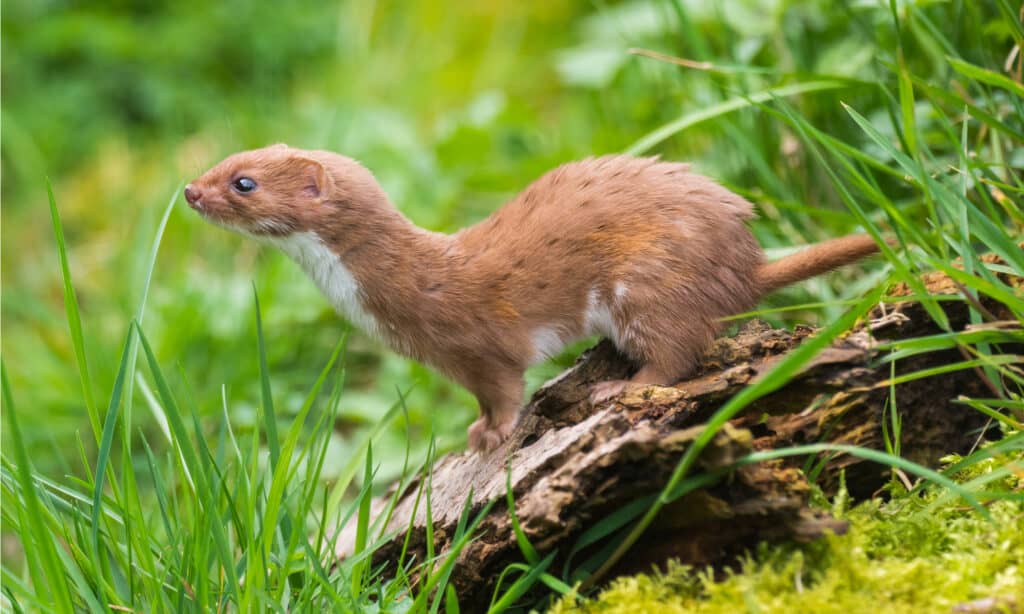
Weasels are one of the many predators of corn snakes.
©Stephan Morris/Shutterstock.com
Conservation
This species isn’t under any threat of extinction. They’re very common, and according to the IUCN Redlist of Threatened Species, their population is probably more than 100,000.
Albino corn snakes are kept primarily as pets and aren’t likely to be found in the wild. They’re easily available from breeders and popular pet snakes.

The IUCN estimates the corn snake population is more than 100,000.
©Tobias Arhelger/Shutterstock.com
Albino (Amelanistic) Corn Snake FAQs (Frequently Asked Questions)
Are albino corn snakes good pets?
Generally, yes. They’re fairly docile and don’t bite often.
How do albino corn snakes hunt?
Like most snakes, they’re primarily ambush predators. However, as a species, corn snakes are relatively active and may seek out their prey.
Do albino corn snakes have health problems?
Not usually, however, their light-colored eyes can make them more sensitive to the light.
What do albino corn snakes eat?
Corn snakes eat rats and mice, and in the wild they may also eat other reptiles, amphibians, or bird eggs.
Thank you for reading! Have some feedback for us? Contact the AZ Animals editorial team.
Sources
- Corn snake, Pantherophis guttatus | Reptarium Reptile Database / Accessed September 13, 2022
- Echternacht, A. & Hammerson, G.A. 2016. Pantherophis guttatus. The IUCN Red List of Threatened Species 2016: e.T63863A71740603. https://dx.doi.org/10.2305/IUCN.UK.2016-3.RLTS.T63863A71740603.en. Accessed on 14 September 2022. / Published July 20, 2015 / Accessed September 13, 2022
- Amelanistic corn snake | Morph Market / Accessed September 14, 2022


















